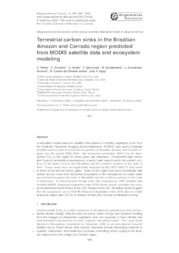Terrestrial carbon sinks in the Brazilian Amazon and Cerrado region predicted from MODIS satellite data and ecosystem modeling.
Terrestrial carbon sinks in the Brazilian Amazon and Cerrado region predicted from MODIS satellite data and ecosystem modeling.
Author(s): POTTER, C.; KLOOSTER, S.; HUETE, A.; GENOVESE, V.; BUSTAMANTE, M.; FERREIRA, L. G.; OLIVEIRA JUNIOR, R. C. de; ZEPP, R.
Summary: A simulation model based on satellite observations of monthly vegetation cover from the Moderate Resolution Imaging Spectroradiometer (MODIS) was used to estimate monthly carbon fluxes in terrestrial ecosystems of Brazilian Amazon and Cerrado regions over the period 2000?2004. Net ecosystem production (NEP) flux for atmospheric CO2 in the region for these years was estimated. Consistently high carbon sink fluxes in terrestrial ecosystems on a yearly basis were found in the western portions of the states of Acre and Rondônia and the northern portions of the state of Pará. These areas were not significantly impacted by the 2002?2003 El Niño event in terms of net annual carbon gains. Areas of the region that show periodically high carbon source fluxes from terrestrial ecosystems to the atmosphere on yearly basis were found throughout the state of Maranhão and the southern portions of the state of Amazonas. As demonstrated though tower site comparisons, NEP modeled with monthly MODIS Enhanced Vegetation Index (EVI) inputs closely resembles the measured seasonal carbon fluxes at the LBA Tapajos tower site. Modeling results suggest that the capacity for use of MODIS Enhanced Vegetation Index (EVI) data to predict seasonal uptake rates of CO2 in Amazon forests and Cerrado woodlands is strong.
Publication year: 2009
Types of publication: Journal article
Unit: Embrapa Eastern Amazon
Keywords: Carbono, Ecossistema
Observation
Some of Embrapa's publications are published as ePub files. To read them, use or download one of the following free software options to your computer or mobile device. Android: Google Play Books; IOS: iBooks; Windows and Linux: Calibre.
Access other publications
Access the Agricultural Research Database (BDPA) to consult Embrapa's full library collection and records.
Visit Embrapa Bookstore to purchase books and other publications sold by Embrapa.

